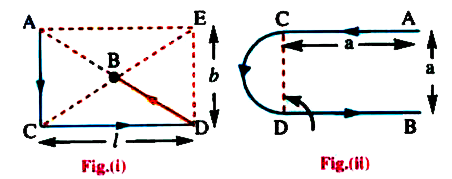The displacement of a particle moving along the x-axis is given by equation x=2t3−2t2+60t+6.The possible acceleration of the particle when its velocity is zero is Solution in Telugu
−18m/s2
30m/s2
9m/s2
−9m/s2
The correct Answer is:A
Step by step video, text & image solution for The displacement of a particle moving along the x-axis is given by equation x=2t^(3)-2"t"^(2)+60t+6.The possible acceleration of the particle when its velocity is zero is by Physics experts to help you in doubts & scoring excellent marks in Class 11 exams.
Updated on:21/07/2023Topper's Solved these Questions
- MOTION IN A STRAIGHT LINEBOOK - AAKASH SERIESCHAPTER - MOTION IN A STRAIGHT LINEEXERCISE - Exercise -3
31 Videos
- MOTION IN A STRAIGHT LINEBOOK - AAKASH SERIESCHAPTER - MOTION IN A STRAIGHT LINEEXERCISE - PROBLEM
47 Videos
- MOTION IN A STRAIGHT LINEBOOK - AAKASH SERIESCHAPTER - MOTION IN A STRAIGHT LINEEXERCISE - Exercise 2A
30 Videos
- MOTION IN A PLANE BOOK - AAKASH SERIESCHAPTER - MOTION IN A PLANE EXERCISE - Practice Exercise
84 Videos
- NEWTONS LAWS OF MOTION BOOK - AAKASH SERIESCHAPTER - NEWTONS LAWS OF MOTION EXERCISE - ADDITIONAL PRACTICE EXERCISE PRACTICE SHEET (ADVANECED) (Matrix Matching Type Questions)
1 Videos
Similar Questions
A particle traversed half of the distance with a velocity of V0. The remaining parts of the distance was covered with velocity V1 for half of the time and with V2 for other half of the time. Find the mean velocity of the particle averaged and the whole time of motion
View SolutionFind the distance covered by the particles in the following figures,
and
while a particle travels from A to B as shown by the arrows

View Solution(A): Displacement of a body may be zero when distance travelled by it is not zero.
(R) : The displacement is the longest distance between initial and final positions..
View SolutionA person runs along a circular path of radius 5m. Find the magnitude of the displacement if he runs all the way around the circle ?
View SolutionThe system shown in the figure is given an acceleration 'a' towards left. Assume all contact surfaces to be smooth (m: mass of the sphere) The magnitude of the contact force between wedge and sphere between wedge and sphere at A is xmg√3 then 'x' is

View SolutionA particle moves along the x-axis obeying the equation x=t(t-1)(t-2) , where x is in meter and t is in second a. Find the initial velocity of the particle. b. Find the initial acceleration of the particle. c. Find the time when the displacement of the particle is zero. d. Find the displacement when the velocity of the particle is zero. e. Find the acceleration of the particle when its velocity is zero.
View SolutionThe displacement x of a particle along the x-axis at time t is given by x=a12t+a23t2. Find the acceleration of the particle.
View SolutionIf the velocity of a particle moving along x-axis is given as v=(3t2−2t) and t=0, x=0 then calculate position of the particle at t=2sec.
View SolutionThe displacement s of a moving particle at a time t is given by s=5+20t−2t2. Find its acceleration when the velocity is zero.
View SolutionIf the displacement of a moving particle is given by s=5+20t−2t2, then acceleration when velocity is zero, is
View SolutionThe displacement -time equation of a particle moving along x -axis is x=t33−t22+20The acceleration -velocity equation of the particle is a2=KV+1 Then the value of K is
View SolutionThe position of a particle moving along x-axis given by x=(−2t3−3t2+5)m. The acceleration of particle at the instant its velocity becomes zero is
View Solutionএকটি বস্তুকণা x-অক্ষ বরাবর যাচ্ছে এবং কোনো মুহূর্তে তার সরণ হল, x(t)=2t3−3t2+4t (SI এককে) কণাটির ত্বরণ যখন শূন্য হবে তখন তার বেগ হবে
View SolutionA particle moves along x-axis and its displacement at any time is given by x(t)=2t3−3t2+4t in SI units. The velocity of the particle when its acceleration is zero is
View SolutionThe displacement x of a particle moving along x-axis at time t is given by x2=2t2+6t. The velocity at any time t is
View SolutionA particle moves along X-axis and its displacement at any time is given by x(t) = 2t^(3) -3t^(2) + 4t in SI units. The velocity of the particle when its acceleration is zero, is
View Solution
